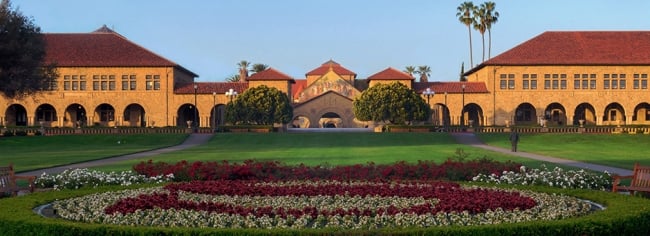You have /5 articles left.
Sign up for a free account or log in.

Stanford University
When The New York Times (courtesy of Raj Chetty at Harvard University) a few years ago decided to examine the issue of wealth and higher education, the figures for Stanford University were striking:
- More than half of Stanford undergraduates came from a family in the top 10 percent of wealth in the United States.
- Thirty-nine percent came from the top 5 percent.
- Seventeen percent came from the top 1 percent.
- And 3.5 percent came from the top 0.1 percent.
And how many are from the bottom 20 percent? Only 4 percent. (Stanford is quite diverse by looking at racial and ethnic groups, with white students making up 32 percent of the population, Asians 23 percent, Latinx 17 percent, Black 7 percent and Native Americans 1 percent.)
As the above numbers indicate, Stanford has a very wealthy student body. And so do most of the other hypercompetitive (in admissions) private colleges.
Faculty at the university have been studying the issue, and the Faculty Senate recently adopted two proposals designed to de-emphasize wealth in admissions.
The first proposal is designed to reduce the influence of wealth in undergraduate admission and to increase the socioeconomic diversity of the undergraduate class. It urges university leaders "to devote resources to improving data collection by modifying Stanford’s application to require applicants to list those who advised or read their application, and to describe their relationship with those people." The Faculty Senate also wants to establish "an improved data system to evaluate the effect of admissions on philanthropic support to the university and to initiate surveys to track the distribution of income and wealth levels for parents and undergraduates."
In addition, the Faculty Senate called for "improved communication that will enhance Stanford’s efforts to publicly describe and demystify the admission process and to reduce disparities among those who can or cannot afford, for instance, private counseling."
Finally, the two proposals extend charges to two committees, the first of which will provide recommendations "about ways to speed review of applications and reduce the influence of consultants in packaging of application materials." The second committee will study alternative funding models for undergraduates.
And the resolutions stressed the faculty role in admissions.
David Lobell, a professor of earth system science at Stanford, led the committee that pushed for the resolutions.
He said, "Stanford has a model of faculty governance, including a committee devoted to admissions policies. So faculty have always been involved in overseeing admissions policies, though not individual admissions decisions, and the Senate meeting was a normal part of that process."
Lobell added that "faculty have been exploring avenues for reducing the influence of wealth in college admission. This is being done within the Faculty Senate and with our Stanford admissions colleagues," so he didn't want to say more.
Ernest Miranda, a spokesman for Stanford, said, "Our faculty set admissions policy for the university, and we will be working with them to implement the proposals adopted at the meeting. In the meeting our provost, Persis Drell, commented on one portion of the proposals, saying she would hope for the administration and the faculty to consult on how best to make the desired application modification without having a negative effect on first-gen and low-income applicants who may receive support in the college search process from nonprofit and community-based organizations."
Ruth A. Starkman teaches writing and rhetoric at Stanford and has worked in admissions at several colleges, and she is a private counselor (with many pro bono students).
She blogged that she offered a "bravo" to the idea of de-emphasizing wealth in admissions.
But Starkman cautioned that some of the approaches being adopted may not yield the results sought.
"Nearly 70 percent of students use some form of college admissions counseling, and while private college admissions counseling has become a booming and greatly controversial business, this percentage offers no clear correlation to wealth. The 2019 college admissions bribery scandal that led to Operation Varsity Blues provided only a partial glimpse into the bad behavior of the ultra-wealthy and their unqualified children. Clearly, not everyone is a monied abuser. Just as not every private college counselor is a high-end corporation that engages in dodgy tactics to boost the uncompetitive elite. In fact, many private counselors are small-business women," she wrote.
She said that, particularly in California, many of the students who receive outside help and are not wealthy are Asian applicants.
"Asian American families who dread being excluded because of their race often over-hire their admissions counselors to help their children beat the odds against them," Starkman wrote. "Sadly, sometimes the effect is detrimental. Of the 10 Bay Area Asian American students I counseled this 2020 cycle, ones who could afford counselors hired a corporation in addition to their school counselor and me, which meant they had at least three different sources of professional -- and often contradictory -- advice. Reading the commentary of these other counselors provides an often painful education in identity marketing. It seems the most common advice of counselors is to 'show leadership and empathy' by writing about some less fortunate, less mentally or physically able student than themselves whom they helped, which thus makes them worthy of admission to an elite university.
"One student wrote her Common Application statement about a friend who just wasn’t as brave as she at public speaking. Another student tried to cheer up a depressed friend during COVID. Yet another intervened in a friend’s eating disorder. Whatever merit these stories of supposed 'leadership and empathy' had, these students were counseled to avoid telling their own stories. Some of my own students inspired by traditional South Asian dance, or a father who had been a Tiananmen Square dissident and escaped to America, or a Vietnamese refugee single mother who raised the student to be a multilingual humanist were redirected to 'leadership and empathy' narratives devoid of Asian content."
She added, "Why make students confess? The process will be messy and could undermine the very community of low-income students admissions hopes to identify. Under such a rule, the 130+ pro bono low-income students I helped from California would have to report they had a 'private college counselor,' or they simply wouldn’t mention it. Such a policy may change nothing except the willingness of applicants to tell the truth."
Starkman wrote that requiring all applicants to submit a simple form on family income -- whether or not they are applying for aid -- would have more of an impact. It "will tell admissions right away who is low income -- and who is rich -- without wading into the murky territory of who is helping the student write their statement."
Donald Hossler, a senior scholar at the Center for Research Policy and Practice of the Rossier School of Education at the University of Southern California, said a central issue for Stanford or other colleges with plenty of wealthy applicants is that "we should not conflate selectivity with the ability to be academically successful at a top" university.
Hossler, who is also Distinguished Provost Professor Emeritus at Indiana University at Bloomington, offered an anecdote and a research-based point via email.
The anecdote: "Perhaps 20 years ago I was asked to moderate a small invitational discussion of a real look [at] behind the scenes data of admissions at a highly selective school. At the time the identity of the institution was supposed to be kept confidential by all of those in attendance so I will not share the name. The institutional researcher from this school at one point described an applicant with a 1290 SAT (back when 1600 was a perfect score) as an at risk student … The head of HR for puffy institutions selected and said ‘wait a minute what happens if you admit a student with a 1290?’ The response was that the student would be just fine."
Hossler continued, "The research based example. The Game of Life: College Sports and Educational Values. In this book [is] the study [of] the academic and career paths of athletes admitted to little Ivies. The test scores at these students while quite good were not as good as the non-athletes admitted. They graduated at similar rates and had successful careers, albeit not as lucrative as other admits (and this comment is mine -- keep in mind that students from more affluent families tend to get jobs where they make more money than the average student -- the best of the occupational status and income of a student is the educational and economic status of the student’s parents). I am not suggesting that any high school graduate could be successful at a Stanford, but we should also not assume that only the very best academically prepared students can be successful."
Angel B. Pérez, CEO of the National Association for College Admission Counseling, said of Stanford and its wealthy students, "It's a complicated question and the answers are deeply ingrained in the culture and operations of higher education."
Many efforts to promote diversity in higher education depend on colleges not only admitting more diverse students, but fewer of the students who have been admitted, he said.
"One angle we don't often think of is the intersection of admission and fundraising," he said. "The majority of institutions are highly dependent on philanthropy to achieve their goals. Often the goal of increasing socioeconomic diversity is directly at odds with an institution's philanthropic efforts. Most development offices do research on the backgrounds of applicants with wealthy parents. Admission officers often wrestle with the challenge of opening the doors wider to low-income students while feeling pressure to admit others whose families could help position the institution for financial success."
Pérez added, "Stanford is certainly an outlier with its multibillion-dollar endowment, but the truth is, most institutions need to admit students from wealthier backgrounds to survive. The tuition and fees colleges charge students is only a fraction of what they spend on their education, especially at residential colleges. American higher education must grapple with its funding model. Until that changes, we aren't going to move the needle very far on diversity efforts."








